New FLIR M300 cameras – visible light, thermal and color thermal

At the NMEA Conference last week, FLIR previewed the M300 line of marine cameras with five models including the company’s first visible light only camera. They also debuted Color Thermal Vision (CTV) and MSX edge enhancing imaging technologies. Ben Ellison and I took a night ride on the FLIR/Raymarine demo boat in busy Norfolk Harbor and saw how all this technology can enhance situational awareness.
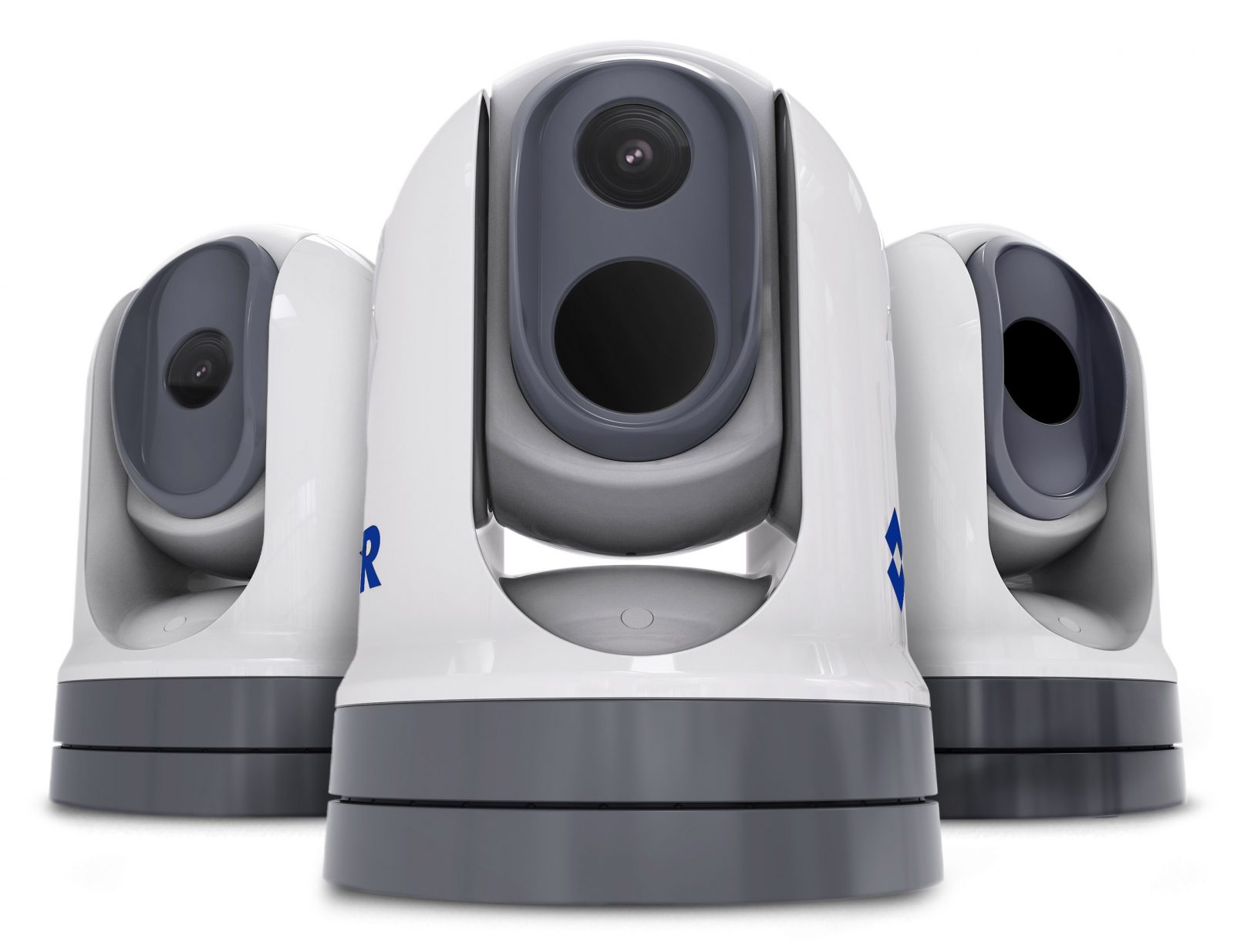
The M300 line adds horizontal stabilization to the previous generation’s vertical stabilization capabilities. To offer horizontal stabilization FLIR has added an attitude heading reference system (AHRS) to all cameras in the line. This means that all cameras can supply acceleration data to a Raymarine Axiom to enable ClearCruise AR without a separate AR200 sensor pack.
CTV & MSX
When paired with a Raymarine Axiom or Axiom Pro MFD, the dual payload models — color and thermal camera equipped — in the M300 lineup can use information from both sensors to present a colorized-thermal image (Color Thermal Vision or CTV) or use the superior resolution of the visible light camera to enhance the edge detail.

CTV is a major advance in this new generation of cameras and it’s pretty impressive to see out on the water. In their press release announcing the new cameras FLIR says, “This proprietary multispectral imaging technology for the FLIR M300 Series and FLIR’s Raymarine Axiom line of navigation displays blends thermal and high-definition visible color video for enhanced identification of buoys, vessels and other targets at night.” The Raymarine Axiom screenshot above demonstrates not only the ability of CTV to add color to the thermal image but also ClearCruise AR overlaying flags on top of AIS targets.

MSX uses the superior resolution of the visible light camera to provide greater edge detail than the thermal sensor alone can provide. Thermal sensors don’t display edge detail well in cases where there’s minimal thermal contrast between objects and with distant objects. MSX allows the detail from the visible light camera to be overlayed on the thermal image. This is the first time FLIR has made MSX available in one of their marine cameras though it has been used in their industrial diagnostic cameras and FLIR One smartphone cameras.
Visible light only model

In a first for FLIR, the M300C ($6,500 MSRP) is a visible-light only camera. With a minimum illumination of 0.0008 lux, FLIR is confident (and we saw proof on our demo ride) that this will enhance the situational awareness of many boaters in low light situations. Like all M300 models, the M300C features two axis stabilization, automatic defrost, and 360 degree continuous pan with 90 degree tilt. The 1/2.8 inch Sony Exmor CMOS sensor is paired with a 30x optical zoom and 12x digital zoom. Without a thermal sensor the M300C won’t be suitable for SAR or true zero lux situations.
Thermal only models
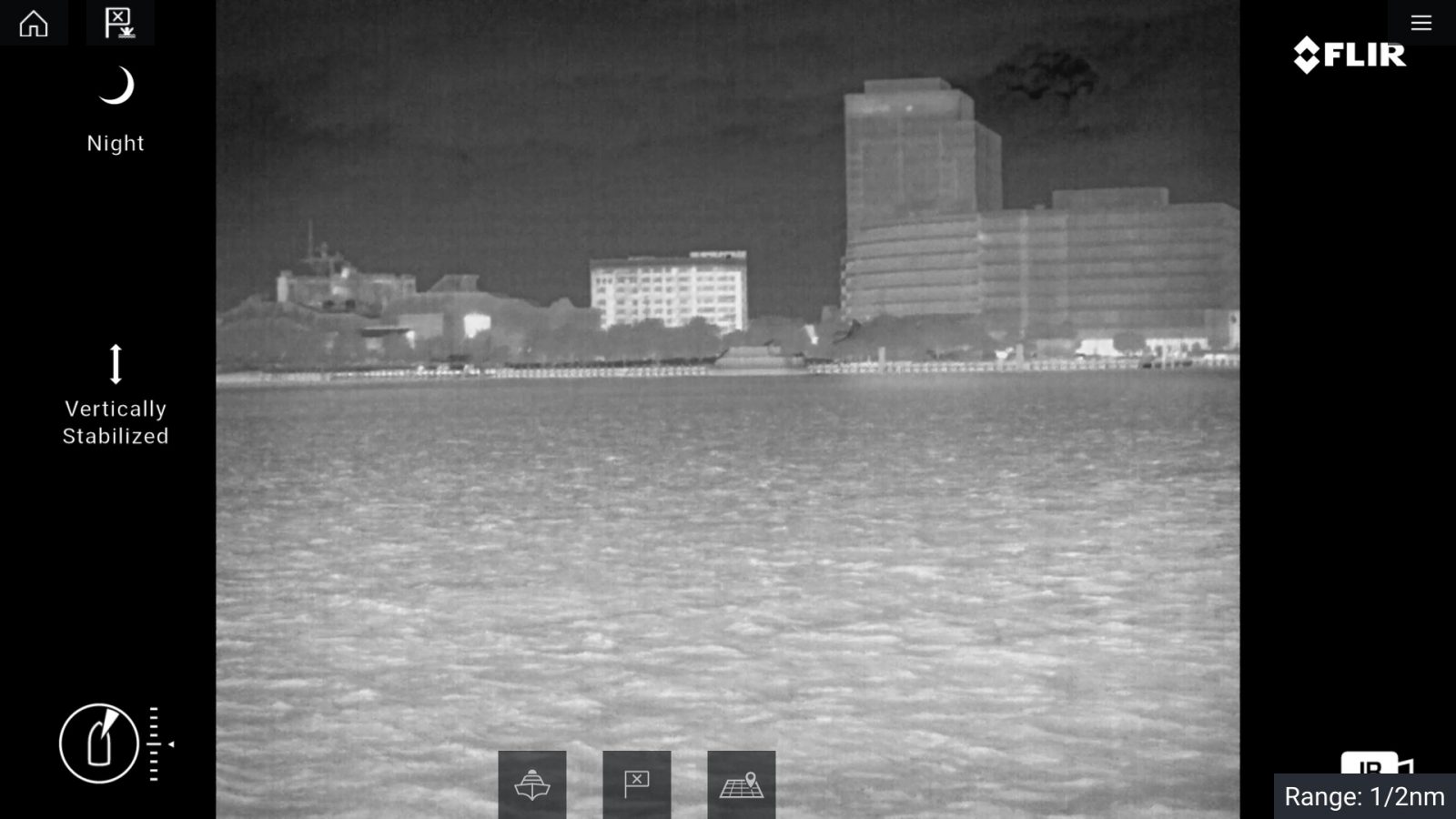
The M300 lineup has two thermal only options. Like all thermal capable cameras in the line, these models utilize FLIR’s Boson core. The $8,500 M332 features a 320 x 256 pixel thermal sensor with gyro-stabilization, pan and tilt. The $14,200 M364 sports a 640 x 512 pixel thermal sensor with the same features as the rest of the line.
Dual payload cameras
The top of the M300 line is occupied by the $20,500 M364C and $29,500 M364C LR dual payload cameras. These cameras are differentiated from each other by their field of view. The M364C has, like all the other thermal cameras in the line, a 24 degree field-of-view, while the long range M364C LR has a narrower 18 degree field-of-view. Both cameras use the 640 x 512 pixel thermal sensor as well as the 1/2.8″ 1080p visible light sensor fitted with a 30x optical zoom lens.
Broad compatibility
All M300 cameras will work well with MFDs from Furuno, Garmin, Navico, and Raymarine. The cameras support touch-enabled pan, tilt and zoom, video over IP, HD-SDI and analog video output, vertical and horizontal stabilization, slew to cue to allow AIS, MARPA and slew to touchpoint, and full access to the outputs of thermal and visible light cameras. The M300 cameras are the first FLIR marine thermal cameras to add ONVIF support. ONVIF will make it easier for other platforms to connect to the cameras without implementing FLIR’s custom API. This will enable compatibility with security products that already support ONVIF. In fact, I became aware of ONVIF support because GOST happily mentioned the compatibility.
Better with Axiom
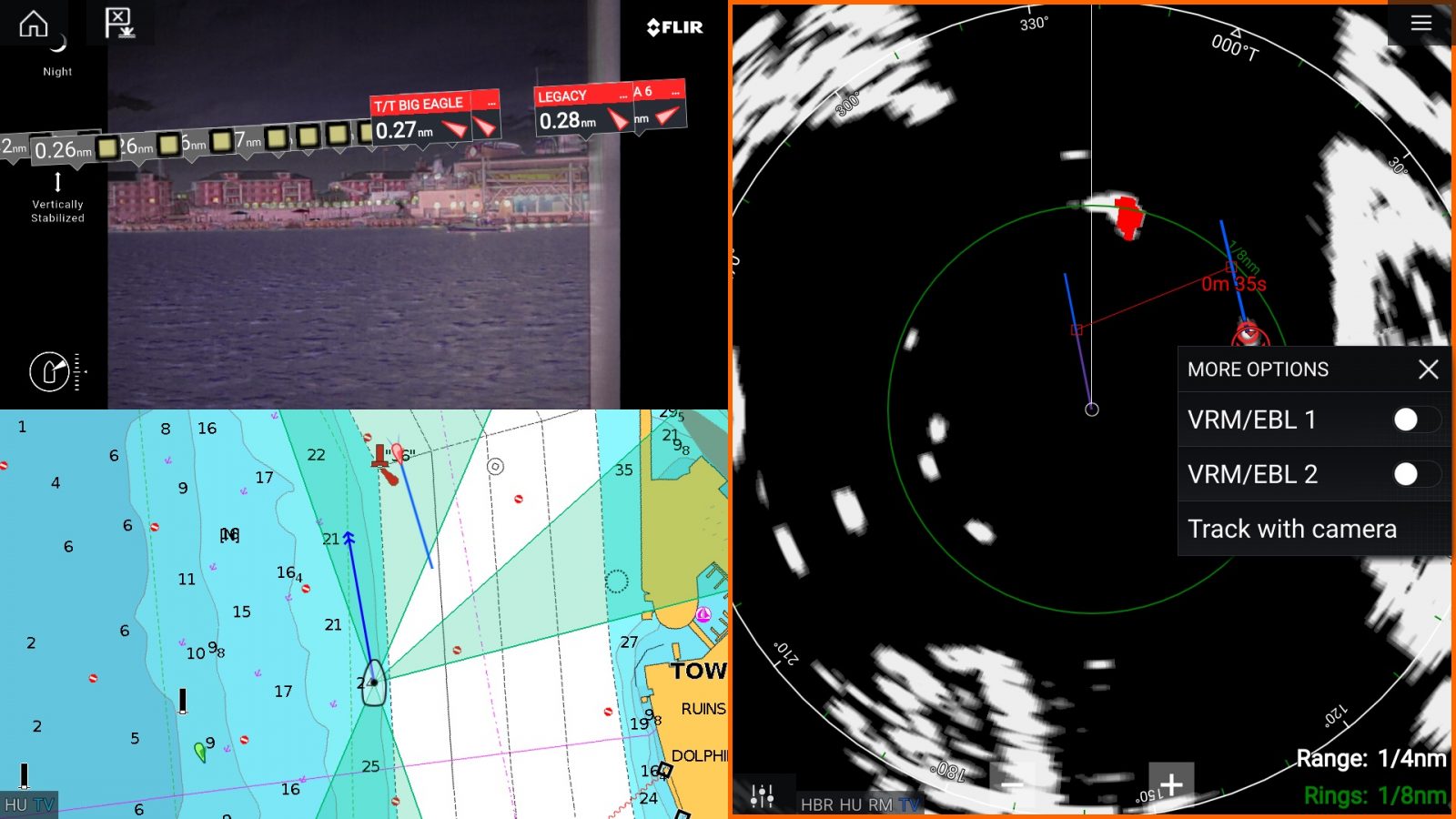
These are highly capable tools for night vision and search and rescue uses when attached to any display. But, when paired with a Raymarine (FLIR owns Raymarine) Axiom or Axiom Pro MFD the capabilities grow dramatically to an exhaustive list of situational-awareness-enhancing tools.
- ClearCruise AR augmented reality overlay
- Color Thermal Vision
- MSX edge detail enhancement
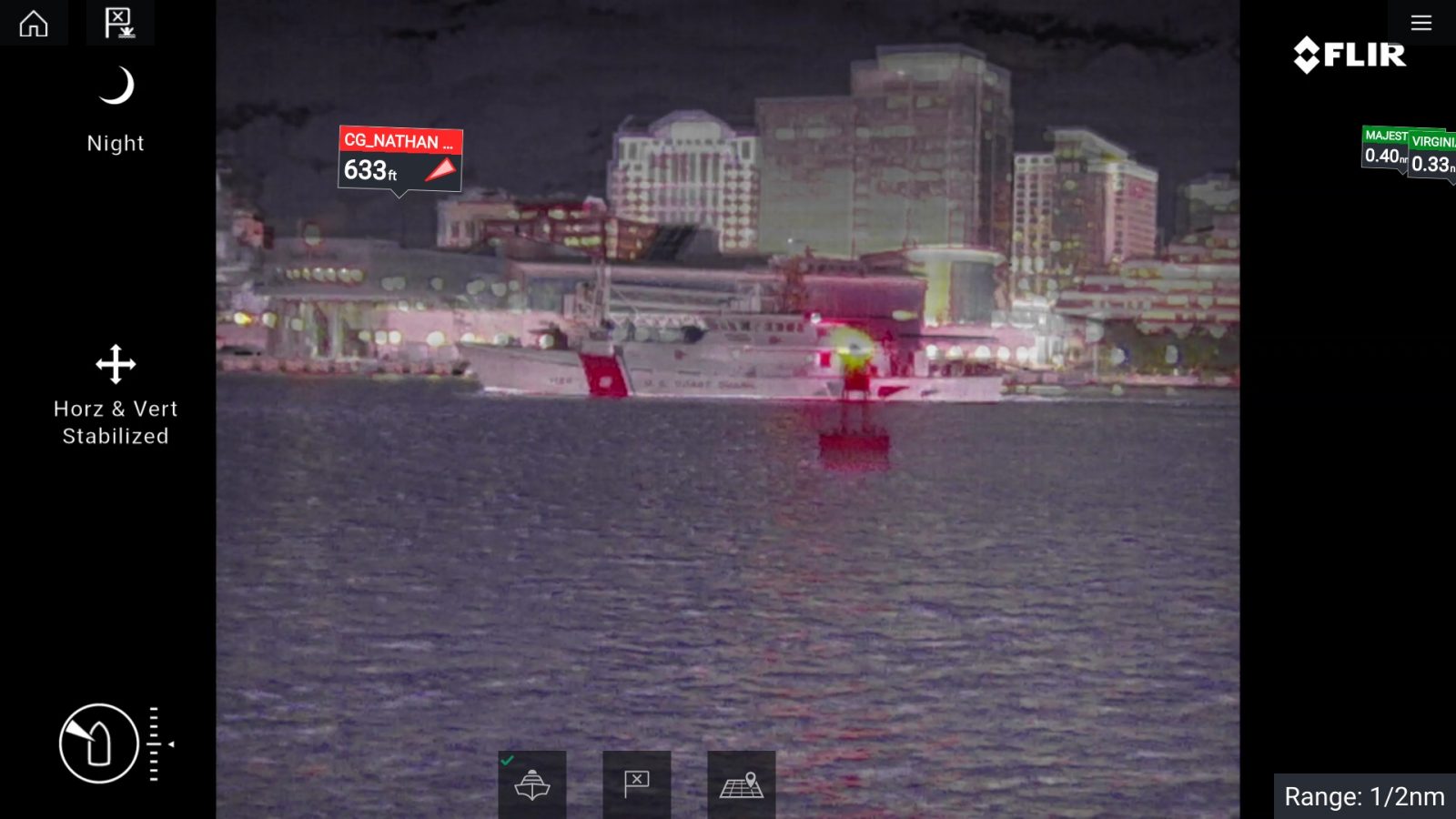
But, all of these features are only available when the cameras are paired with an Axiom or Axiom Pro. The screenshots and video above show quite a few of these technologies in use together and demonstrate the utility of the features layered together. The Axiom line starts with the $650, 7-inch, Axiom 7. Even if you have a large installation of another manufacturer’s MFDs I believe the investment in at least one Axiom is money well spent to get the most out of these cameras.



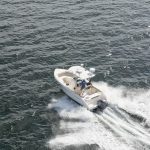









Looks fantastic! Do you know if these cameras support the clearcruise object detection feature?
Raymarine says that the cameras are capable of ClearCruise but, at launch these cameras won’t have it. ClearCruise will be added in an upcoming release along with some other unannounced features.
Terrific. I’ve been working on a big refit for my 1967 Cal48 and I standardized on Axiom and Raymarine. The AR feature is really great but didn’t want to have two separate cameras (1 FLIR and 1 vis) on the mast. The combination of both cameras into a single stabilized unit greatly simplifies and enhances adding AR to my boat.
I agree with young Ben that Raymarine displays have gotten so good with cameras that on some boats that may make sense as their main use, with chart plotting, sonar, radar etc. as nice optional and/or backup uses. And it’s not just the special features discussed above. Managing camera settings, snapping photos (higher res than screenshots), and taking videos is all easy with the Axiom operating system.
Also, while I’ve been pleased using a Ray CAM220 and a FLIR M232 with Axiom, I’ve recently learned that Axiom supports other brand IP cameras via ONVIF. In other words, Raymarine is extending its marine camera platform beyond its own camera family, which I like.
Specifically, Iris Innovations says that all their fixed IP cameras work fine with Axiom, and they’re checking their PTZ (pan, tilt, zoom) models. (And hope to have detail on interesting new Iris cams shown at NMEA soon.)
https://www.boat-cameras.com
Ben’s mention of broader ONVIF support made me realize I should expand on my own use of ONVIF cameras aboard Have Another Day. For the last 3.5-4 years I’ve been using first LightHouse II and now LightHouse III’s ONVIF capabilities to display the output from inexpensive multi-megapixel IP Cameras.
I’ll do a more thorough writeup soon, but here’s the camera app on one of my Axiom’s happily displaying the output of a $40 -$50 camera as well as a Raymarine CAM210 and FLIR M232.
I’ve gotten a few requests for additional footage from the demo ride. I’ve uploaded more clips and created a playlist with all the videos. It can be viewed at https://www.youtube.com/playlist?list=PLT7Rz6ze0XymoEe7-JppjKHhsKR8Dlnmf.
This is very interesting. Perhaps we could discuss some of the less expensive hand held units for us boaters that don’t need the full time capability of the built in units. What would be good units to consider for night running and fog running. There’s a lot of choices out there.
Hi Ben,
Where did you get the information that the cameras will support ClearCruise AR without an AR200? What I’ve been getting is that even with the M300 series cameras an AR200 will be required to enable ClearCruise AR, but won’t be necessary for ClearCruise.
Hi Joe. I apologize for the confusion. This erroneous info probably came from me during our NMEA preview event when I first showed this new platform to team Panbo. In the pre-launch excitement I may have misunderstood the camera’s capabilities, missed a change in the product, or a bit of both.
The Attitude and Heading Reference Sensor (AHRS) in the M300-series camera gimbal is used for its own vertical and horizontal stabilization, but not for Augmented Reality (AR). AR does rely on the AR200 Stabilization Module to be in the network. That sensor has GPS, AHRS, and additional specialized algorithms inside which provides additional information to the Axiom MFDs to keep the AR overlay stabilized and synchronized with the visible or thermal video.
Please don’t hesitate to ask if you have any other questions about the the product.
Best Regards,
Jim McGowan
Marketing Manager, Americas
FLIR Maritime | Raymarine
[email protected]
Hi Jim
I have just purchased a new M364CLR camera for our new 80ft.sports cruiser and i have 3 x 22 inch Garmin screens.
What features do i miss out on from the camera by not having Raymarine screens
Hi Ray,
I suspect Jim is in Fort Lauderdale right now preparing for the boat show. I believe the biggest things you will give up by not having the M364 connected to an Axiom or Axiom Pro would be ClearCruise AR, color thermal and MSX edge detail enhancement.
Ben
This investigative journalism may cause rage and/or depression, but credit to FLIR for developing thermal cameras that can image normally invisible methane gas leaks:
https://www.nytimes.com/interactive/2019/12/12/climate/texas-methane-super-emitters.html
I notice a lot of Vendee Globe participants have Oscar systems for collision avoidance. Would that be more effective than a 300 series FLIR at detecting trees, and other debris in the ocean?
I don’t know, Maldwin, but I do see that Oscar uses FLIR thermal camera cores and then adds a lot of artificial intelligence. And thanks for sending me a head’s up email about this new system. I’m on the case and hoping that the Vendee will proof it effective (also GO ALEX!):
https://www.oscar-navigation.com/
https://www.alexthomsonracing.com/the-hub/